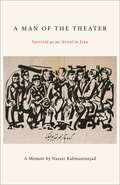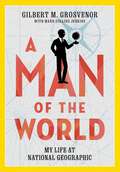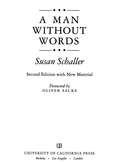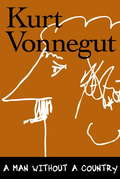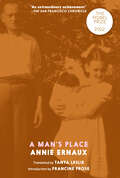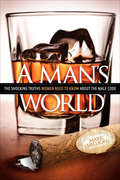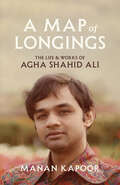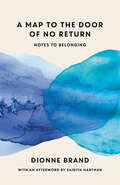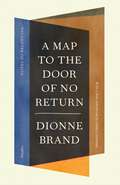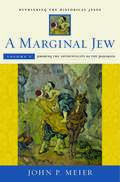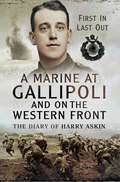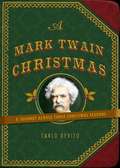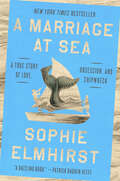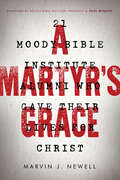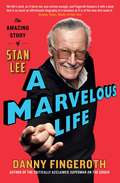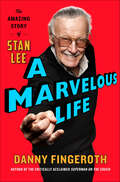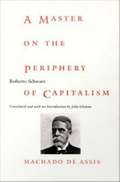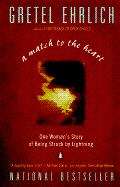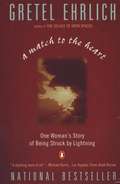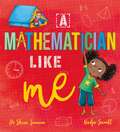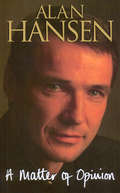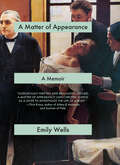- Table View
- List View
A Man of the Theater: Survival as an Artist in Iran
by Nasser RahmaninejadLife in Iran as an artist under the Shah and during the Iranian RevolutionA Man of the Theater tells the personal story of a theater artist caught between the two great upheavals of Iranian history in the 20th century. One is the White Revolution of the 1960s, the incomplete and uneven modernization imposed from the top by the dictatorial regime of the Shah, coming in the wake of the overthrow of the popular Mosaddegh government with the help of the CIA. The other one is the Iranian Revolution of 1979, a great rising of Iranian society against the rule of the Shah in which Khomeini’s Islamist faction ends up taking power. Written in a simple direct style, Rahmaninejad’s memoir describes his fraught creative life in Tehran during these decades, founding a theater company and directing plays under the increasing pressure of the censorship authorities and the Shah’s secret police. After being arrested and tortured by the SAVAK and after spending years in Tehran’s infamous Evin prison and being a cause célèbre of Amnesty International, Rahmaninejad is freed by the Revolution of 1979. But his new-found freedom is short-lived; the progressive intellectuals and artists find themselves overpowered and outmaneuvered by the better organized Islamists, leading to renewed terror and to exile. In Western perception, the Iranian Revolution, which this year has its 40th anniversary, often overshadows the decades of Iran’s modern history that preceded it. A Man of the Theater fills this gap. The title derives from a time of torture in prison when interrogators ordered him to write everything about his activities. To avoid revealing anything incriminating he took pen in hand and wrote and wrote about all his artistic passions, beginning, "Here it is—this is my life! I am an artist! A man of the theater!"
A Man of the World: My Life at National Geographic
by Gilbert M GrosvenorThe captivating inside story of the man who helmed National Geographic over the course of six decades is a front-row seat to iconic feats of exploration, from the successful hunt for the Titanic to Jane Goodall's field studies, offering a rare portrait of one of the most iconic media empires in history and making an impassioned argument for our enduring need to know and care for our world.Though his career path had been paved by four generations of his family before him, Gilbert M. Grosvenor left his own mark on the National Geographic Society, founded in 1888 and recognised the world over by its ubiquitous yellow border. In an unflinchingly honest memoir as big as the world and all that is in it, Grosvenor shows us what it was like to "grow up Geographic" in a family home where explorers like Robert Peary, Louis Leakey, and Jane Goodall regularly crossed the threshold. As staff photographer, editor in chief and then president of the organisation, Grosvenor oversaw the diversification into television, film, books, as well as its flagship magazine, which under his tenure reached a peak circulation of nearly 11 million. He also narrates the shift from a nonprofit, family-focused enterprise to the more corporate, bottom-line focused world of publishing today.For Grosvenor, running National Geographic wasn&’t just a job. It was a legacy, motivated by a passion not just to leave the world a better place, but to motivate others to do so, too. Filled with world travel, charismatic explorers, and the complexities of running a publishing empire, A MAN OF THE WORLD is the story of one man, a singular family business, and the changing face of American media.
A Man without Words
by Susan SchallerA Man without Words vividly conveys the challenge, the frustrations, and the exhilaration of opening the mind of a congenitally deaf person to the concept of language.
A Man without a Country
by Kurt Vonnegut Jr. Daniel SimonA Man Without a Country is Kurt Vonnegut's hilariously funny and razor-sharp look at life ("If I die--God forbid--I would like to go to heaven to ask somebody in charge up there, 'Hey, what was the good news and what was the bad news?"), art ("To practice any art, no matter how well or badly, is a way to make your soul grow. So do it."), politics ("I asked former Yankees pitcher Jim Bouton what he thought of our great victory over Iraq and he said, 'Mohammed Ali versus Mr. Rogers.'"), and the condition of the soul of America today ("What has happened to us?"). Based on short essays and speeches composed over the last five years and plentifully illustrated with artwork by the author throughout, A Man Without a Country gives us Vonnegut both speaking out with indignation and writing tenderly to his fellow Americans, sometimes joking, at other times hopeless, always searching.
A Man's Place
by Annie Ernaux Tanya LeslieAnnie Ernaux's father died exactly two months after she passed her practical examination for a teaching certificate. Barely educated and valued since childhood strictly for his labor, Ernaux's father had grown into a hard, practical man who showed his family little affection. Narrating his slow ascent towards material comfort, Ernaux's cold observation reveals the shame that haunted her father throughout his life. She scrutinizes the importance he attributed to manners and language that came so unnaturally to him as he struggled to provide for his family with a grocery store and cafe in rural France. Over the course of the book, Ernaux grows up to become the uncompromising observer now familiar to the world, while her father matures into old age with a staid appreciation for life as it is and for a daughter he cautiously, even reluctantly admires. A Man's Place is the companion book to her critically acclaimed memoir about her mother, A Woman's Story.
A Man's Reach
by Elmer L. Andersen Lori SturdevantAutobiography of the popular Minnesota Governor in the 1950's.
A Man's Stature
by Henry Viscardi Bernard M. BaruchThe autobiography of Henry Viscardi, a man who grew up in the 1930s with physically disabled legs and a short stature. Through hard work and determination, Henry obtains educational, job, and personal success. Fitted with prostetic legs at age 25, Henry goes on to heading an organization to help people with disabilities obtain jobs.
A Man's World: The Shocking Truths Women Need to Know About the Male Code
by Mark MillionThere is a secret world in which every man inherently belongs. It’s an unseen world of persuasive male influence driven by greed, selfish desires, and dangerous dark motives fueled by incessant self-gratification. “No woman is ever to know.” These thoughts and feelings aren’t limited to your everyday man, but shared by the highly educated and powerful men of society as well. I witnessed this firsthand after having the opportunity to meet these high-powered men. From the biggest celebrities and sports stars to the wealthiest men on our planet, we all instinctively protect the male code because it gives us a supreme advantage over the women of our society. Most women think they know everything there is to know about the men in their lives. The truth is every man lives two lives. One is the deceptive illusion we are taught to present to society and the women in it. The second is the real man only seen by other men. We men discuss this subject openly in our social world, but never to reveal it to women because that would break the male code. It’s between men and men only…Until now.
A Map of Longings: The Life and Works of Agha Shahid Ali
by Manan KapoorThe beautifully written first biography of one of the world’s finest twentieth-century poets Agha Shahid Ali (1949–2001) was one of the most celebrated American poets of the latter twentieth century, and his works have touched millions of lives around the world. Traversing multiple geographies, cultures, religions, and traditions, he mapped the varied landscapes of the Indian subcontinent and the United States. In this biography, Manan Kapoor narrates Shahid’s evolution, following in the footsteps of the “Beloved Witness” from Kashmir and New Delhi to the American Southwest and Massachusetts. He charts Shahid’s friendships with literary figures such as James Merrill, Salman Rushdie, and Edward Said; explores how Shahid responded to events around the world, including the partition of the Indian subcontinent and the AIDS epidemic in America; and draws on unpublished materials and in-depth interviews to reveal the experiences and relationships that informed his poetry. Hailed upon its release in India as “lush” and “poetic,” A Map of Longings is the story of an extraordinary poet, the works he left behind, and the legacy of his singular poetic vision.
A Map to the Door of No Return: Notes to Belonging
by Dionne BrandA Map to the Door of No Return is a timely book that explores the relevance and nature of identity and belonging in a culturally diverse and rapidly changing world. It is an insightful, sensitive and poetic book of discovery. Drawing on cartography, travels, narratives of childhood in the Caribbean, journeys across the Canadian landscape, African ancestry, histories, politics, philosophies and literature, Dionne Brand sketches the shifting borders of home and nation, the connection to place in Canada and the world beyond. The title, A Map to the Door of No Return, refers to both a place in imagination and a point in history -- the Middle Passage. The quest for identity and place has profound meaning and resonance in an age of heterogenous identities. In this exquisitely written and thought-provoking new work, Dionne Brand creates a map of her own art.
A Map to the Door of No Return: Notes to Belonging
by Dionne BrandNow in its first American edition, Dionne Brand’s groundbreaking A Map to the Door of No Return has emerged as a modern classic, a highly influential exploration of “being” in the Black Diaspora.Since its first publication in 2001, Dionne Brand’s groundbreaking exploration of being in the Black Diaspora, A Map to the Door of No Return, has emerged as a modern classic. The door, in Brand’s iconic schema, represents the point of rupture where the ancestors of the Black Diaspora departed one world for another: the place where all names were forgotten, and all beginnings recast. “This door,” writes Brand, “is not mere physicality. It is a spiritual location . . . Since leaving was never voluntary, return was, and still may be, an intention, however deeply buried. There is as it says no way in; no return.” Through shards of history, memoir, lyrical investigation, and the unwritten experience of so many descendants of those who passed through the door, Brand constructs a map of this indelible region, culminating in an enduring expression, both definitive and seeking, of what it is to live, think, and create in the wake of colonization. With a new preface by the author, and an afterword by Saidiya Hartman.
A Marginal Jew: Rethinking the Historical Jesus, Volume V
by John P. MeierSince the late nineteenth century, New Testament scholars have operated on the belief that most, if not all, of the narrative parables in the Synoptic Gospels can be attributed to the historical Jesus. This book challenges that consensus and argues instead that only four parables—those of the Mustard Seed, the Evil Tenants, the Talents, and the Great Supper—can be attributed to the historical Jesus with fair certitude. In this eagerly anticipated fifth volume of A Marginal Jew, John Meier approaches this controversial subject with the same rigor and insight that garnered his earlier volumes praise from such publications as the New York Times and Christianity Today. This seminal volume pushes forward his masterful body of work in his ongoing quest for the historical Jesus.
A Marine at Gallipoli on the Western Front: First In, Last Out: The Diary of Harry Askin
by Harry AskinHarry Askin was 22 when he enlisted at Nottingham in September 1914 and was sent to train with the Royal Marines at Portsmouth.He set sail with the Mediterranean Expeditionary Force in late February 1915. On 25 April he was towed ashore to Gallipoli. So began a nine month ordeal of constant fighting and shelling on that bare and desperate Peninsula.In this diary he captures the atmosphere of danger and death, blazing heat in summer and rain and cold at other times. The smell of dead bodies was everywhere and while the fortitude of the troops was astonishing, at times confusion and panic prevailed. Harry was wounded twice in one day but the surgeon removed the bullet and he returned to the firing line.Harry was among the last to withdraw and his reward was to be sent to the Western Front. Again he was wounded. This is a stirring memoir which paints a vivid picture of the horrors of war.
A Mark Twain Christmas
by Carlo DevitoFilled with the remarkable wit and humor of America's favorite storyteller, A Mark Twain Christmas gives readers insight into Twain's life through little known stories about how he and his family celebrated this treasured holiday."If my boot should leave a stain on the marble...leave it there always in memory of my visit...and let it remind you to be a good little girl." When Market Twain penned this enchanting letter from "Your loving Santa Claus" to his daughter Susy in 1875, a holiday tradition was born inside the Twain family home. And while Twain is celebrated as the sharpest satirist in American letters, he always had a soft spot for Christmas. A Mark Twain Christmas is in turns charming, heartwarming, and heartbreaking, and it ultimately reaffirms the magic of the Christmas spirit. Looking in on three holiday seasons with Twain, we learn more about the man than we ever knew before, and we discover fascinations from gifted elephants to burglar letters to Santa's bootprints. But most of all, we regain an understanding of what is most important in our own lives, and that is the greatest gift of the Christmas season.
A Marriage at Sea: A True Story of Love, Obsession, and Shipwreck
by Sophie Elmhirst&“Gird your loins and line up your couple&’s therapist.&” – New York Times Book Review podcast&“This is nonfiction that reads like fiction – the best kind. Elmhirst&’s retelling is a triumph, second only to the seemingly impossible feat of Maurice and Maralyn themselves. You won&’t be able to put it down.&” – USA Today&“Such an emotionally vivid portrait of a couple in isolation that I was shocked it wasn&’t fiction. How could a writer get so deeply into the minds of two real people in such extraordinary circumstances? … So brilliantly depicted.&” – Elle, Best Books of Summer&“A beautiful meditation on endurance, codependence, and the power of love. A dazzling book.&” – Patrick Radden Keefe&“An enthralling, engrossing story of survival and the resilience of the human spirit.&” —Bill BrysonThe electrifying true story of a young couple shipwrecked at sea: a mind-blowing tale of obsession, survival, and partnership stretched to its limits.Maurice and Maralyn make an odd couple. He&’s a loner, awkward and obsessive; she&’s charismatic and ambitious. But they share a horror of wasting their lives. And they dream – as we all dream – of running away from it all. What if they quit their jobs, sold their house, bought a boat, and sailed away?Most of us begin and end with the daydream. But in June 1972, Maurice and Maralyn set sail. For nearly a year all went well, until deep in the Pacific, a breaching whale knocked a hole in their boat and it sank beneath the waves.What ensues is a jaw-dropping fight to survive in the wild ocean, with little hope of rescue. Alone together for months in a tiny rubber raft, starving and exhausted, Maurice and Maralyn have to find not only ways to stay alive but ways to get along, as their inner demons emerge and their marriage is put to the greatest of tests. Although they could run away from the world, they can&’t run away from themselves.Taut, propulsive, and dazzling, A Marriage at Sea pairs an adrenaline-fueled high seas adventure with a gutting love story that asks why we love difficult people, and who we become under the most extreme conditions imaginable.
A Martyr's Grace: 21 Moody Bible Institute Alumni Who Gave Their Lives for Christ
by Marvin J. Newell"Have you grace to be a martyr?" D.L. Moody was once asked."No," he replied, "I have not. But if God wanted me to be one, he would give me a martyr's grace."They came from around the world. Administrators, teachers, doctors and nurses, church planters and pilots. Regular people in the prime of life.In A Martyr&’s Grace, Marvin Newell tells the individual stories of these faithful men and women who made a difference in the places they served. He also describes—in many cases for the very first time—how Jesus called them home. Their legacies live on in the rainforests, villages, churches, and cities where they died. What is it that compels ordinary people to sacrifice their lives in this way? Only Christ. They didn&’t go expecting to die. But they went—having already given their lives.
A Marvelous Life: The Amazing Story of Stan Lee
by Danny FingerothStan Lee invented SPIDER-MAN! And IRON MAN! And the HULK! And the X-MEN! And more than 500 other iconic characters! His name has appeared on more than a billion comic books, in 75 countries, in 25 languages. His creations have starred in multibillion-dollar grossing movies and TV series. This is his story.Danny Fingeroth writes a comprehensive biography of this powerhouse of ideas who changed the world&’s understanding of what a hero is and how a story should be told, while exploring Lee's unique path to becoming the face of comics. With behind-the-scenes stories and interviews with Stan&’s brother Larry Lieber and other industry legends, The Marvelous Life has insights that only an insider like Fingeroth can offer. Fingeroth, himself a longtime writer and editor at Marvel Comics and now a lauded pop culture critic and historian, knew and worked with Stan Lee for over three decades. Due to this connection, Fingeroth is able to put Lee&’s life and work in a context that makes events and actions come to life as no other writer could.
A Marvelous Life: The Amazing Story of Stan Lee
by Danny FingerothThe definitive biography of the beloved—often controversial—co-creator of many legendary superheroes, A Marvelous Life: The Amazing Story of Stan Lee presents the origin of “Stan the Man,” who spun a storytelling web of comic book heroic adventures into a pop culture phenomenon: the Marvel Universe."[Fingeroth's] intimate yet balanced account, highlights Lee’s humanity, humor and even humility. But it doesn’t ignore how his canny self-promotion at times shortchanged his collaborators and constrained his own choices." —Wall Street JournalStan Lee was the most famous American comic book creator who ever lived.Thanks, especially, to his many cameos in Marvel movies and TV shows, Lee was—and even after his 2018 death, still is—the voice and face of comics and popular culture in general, and Marvel Comics in particular. How he got to that place is a story that has never been fully told—until now.With creative partners including Jack Kirby and Steve Ditko—with whom he had tempestuous relationships that rivaled any superhero battle—Lee created world-famous characters including Spider-Man, Iron Man, the X–Men, the Avengers, and the Hulk!But Lee’s career was haunted by conflict and controversy. Was he the most innovative creator to ever do comics? Was he a lucky no-talent whose only skill was taking credit for others’ work? Or was he something else altogether? Danny Fingeroth’s A Marvelous Life: The Amazing Story of Stan Leeattempts to answer some of those questions. It is the first comprehensive biography of this powerhouse of ideas who, with his invention of Marvel Comics, changed the world’s ideas of what a hero is and how a story should be told. With exclusive interviews with Lee himself, as well as with colleagues, relatives, friends—and detractors—Fingeroth makes a doubly remarkable case for Lee’s achievements, while not ignoring the controversies that dogged him his entire life—and even past his death. With unique access to Lee’s personal archives at the University of Wyoming, Fingeroth explores never-before-examined aspects of Lee’s life and career, and digs under the surface of what people thought they knew about him.Fingeroth, himself a longtime writer and editor at Marvel Comics, and now a lauded pop culture critic and historian, knew and worked with Stan Lee for over four decades. With his unique insights as a comics world insider, Fingeroth is able to put Lee’s life and work in a unique context that makes events and actions come to life as no other writer could. Despite F. Scott Fitzgerald’s famous warning that “There are no second acts in American lives,” Stan Lee created a second act for himself that changed everything for him, his family, his industry, and ultimately for all of popular culture. How he did it—and what it cost him—is a larger-than-life tale of a man who helped create the modern superhero mythology that has become a part of all our lives.
A Master on the Periphery of Capitalism: Machado De Assis
by Roberto SchwarzA Master on the Periphery of Capitalism is a translation (from the original Portuguese) of Roberto Schwarz's renowned study of the work of Brazilian novelist Machado de Assis (1839-1908). A leading Brazilian theorist and author of the highly influential notion of "misplaced ideas," Schwarz focuses his literary and cultural analysis on Machado's The Posthumous Memoirs of Brás Cubas, which was published in 1880. Writing in the Marxist tradition, Schwarz investigates in particular how social structure gets internalized as literary form, arguing that Machado's style replicates and reveals the deeply embedded class divisions of nineteenth-century Brazil. Widely acknowledged as the most important novelist to have written in Latin America before 1940, Machado had a surprisingly modern style. Schwarz notes that the unprecedented wit, sarcasm, structural inventiveness, and mercurial changes of tone and subject matter found in The Posthumous Memoirs of Brás Cubas marked a crucial moment in the history of Latin American literature. He argues that Machado's vanguard narrative reflects the Brazilian owner class and its peculiar status in both national and international contexts, and shows why this novel's success was no accident. The author was able to confront some of the most prestigious ideologies of the nineteenth century with some uncomfortable truths, not the least of which was that slavery remained the basis of the Brazilian economy. A Master on the Periphery of Capitalism will appeal to those with interests in Latin American literature, nineteenth century history, and Marxist literary theory.
A Match to the Heart
by Gretel EhrlichAfter nature writer Gretel Ehrlich was struck by lightning near her Wyoming ranch and almost died, she embarked on a grueling but often exhilarating journey back to the land of the living. Here she invites readers to share that journey, as she hungrily explores the natural and spiritual world to try and make sense of what happened to her.
A Match to the Heart: One Woman's Story of Being Struck By Lightning
by Gretel EhrlichA powerful chronicle of a wounded woman's exploration of nature and selfAfter nature writer Gretel Ehrlich was struck by lightning near her Wyoming ranch and almost died, she embarked on a painstaking and visionary journey back to the land of the living. With the help of an extraordinary cardiologist and the companionship of her beloved dog Sam, she avidly explores the natural and spiritual world to make sense of what happened to her. We follow as she combs every inch of her new home on the California coast, attends a convention of lightning-strike victims, and goes on a seal watch in Alaska. Ehrlich then turns her focus inward, exploring the tiny but equally fascinating ecosystem of the human heart, and culminated in a stunningly beautiful description of open-heart surgery.
A Mathematician Like Me
by Dr Shini SomaraStriking illustrations and an empowering story combine to introduce young readers to the world of maths, creative thinking and problem-solving.Setting off on a camping adventure with her cousin, Aliyah soon discovers that numbers are everywhere, whether it's counting out money at the shops, planning trips on the train or even stargazing in a forest. As Aliyah solves some sums of her own, she learns about the brilliant mathematicians who have helped us understand our world. Soon she can't wait to become a maths whizz too!With pages encouraging kids to play maths games with their friends, this brilliant picture book written by engineer and TV presenter Dr Shini Somara unlocks a love of numbers and creative thinking, and celebrates women in STEM.Also available in the series:- A Scientist Like Me- A Coder Like Me- An Engineer Like Me
A Mathematician's Apology
by G. H. HardyG. H. Hardy was one of this century's finest mathematical thinkers, renowned among his contemporaries as a 'real mathematician … the purest of the pure'. He was also, as C. P. Snow recounts in his Foreword, 'unorthodox, eccentric, radical, ready to talk about anything'. This 'apology', written in 1940, offers a brilliant and engaging account of mathematics as very much more than a science; when it was first published, Graham Greene hailed it alongside Henry James's notebooks as 'the best account of what it was like to be a creative artist'. C. P. Snow's Foreword gives sympathetic and witty insights into Hardy's life, with its rich store of anecdotes concerning his collaboration with the brilliant Indian mathematician Ramanujan, his idiosyncrasies and his passion for cricket. This is a unique account of the fascination of mathematics and of one of its most compelling exponents in modern times.
A Matter Of Opinion
by Alan HansenFootball is a game of opinions. Alan Hansen knows this only too well. In his long, distinguished career with Liverpool he faced some fierce public criticism from the media. Now the boot is on the other foot and Hansen himself earns a living as one of football's most outspoken and popular pundits.Hansen's autobiography is as uncompromising as the man himself. Looking back at fourteen victorious years at Anfield, he focuses on the highlights and the inspirational characters - Paisley, Fagan, Dalglish, Rush - who were so instrumental in building the club's international success. Then there were the disappointments, and the darker days at Heysel and Hillsborough. Hansen reflects on the impact both incidents had on his life, and on the future for spectators of British football.In 1991 Hansen retired from football. He explains his reasons for not wanting to stay in the game, revealing a surprising lack of self-confidence. If he were starting his playing career now, who are the teams he would want to play for - and those he wouldn't? Which managers and players does he respect? Why does he admire Wimbledon above all other home teams? Hansen addresses these questions and, now that clubs are becoming multi-faceted business empires, looks at the future for the game in the UK.Until a knee injury ended his playing career, Hansen was one of the most successful British soccer players of all time. He captained Liverpool to an historic double in 1986, and is the only person to have won all of the honours available at club level at least twice. A keen tactical understanding of the game has made him a favourite on BBC TV Match of the Day, Grandstand and Sportsnight. Before embarking on his professional playing career, Hansen was awarded a place at Aberdeen University to read history. He lives with his family in Merseyside.
A Matter of Appearance: A Memoir
by Emily WellsA dazzling memoir of chronic illness that explores the fraught intersection between pain, language, and gender, by a debut author.Emily Wells spent her childhood dancing through intense pain she assumed was normal for a ballerina pushing her body to its limits. For years, no doctor could tell Wells what was wrong with her, or they told her it was all in her head.In A Matter of Appearance, Wells traces her journey as she tries to understand and define the chronic pain she has lived with all her life. She draws on the critical works of Freud, Sontag, and others to explore the intersection between gender, pain, and language, and she traces a direct line from the &“hysteria patients&” at the Salpêtrière Hospital in nineteenth-century Paris to the contemporary New Age healers in Los Angeles, her stomping ground. At the crux of Wells&’ literary project is the dilemma of how to diagnose an experience that is both private and public, subjective and quantifiable, and how to express all this in words.&“Gorgeously written and brilliantly argued, A Matter of Appearance uses chronic illness as a lever to investigate the life of a body. It&’s complex, inconclusive, and incredibly clear-eyed. Moving fluidly between histories of psychoanalysis, desire, ambition, pathology, Wells reminds us of the liminal state we all live in between sickness and health.&”—Chris Kraus, author of Aliens & Anorexia and Summer of Hate
